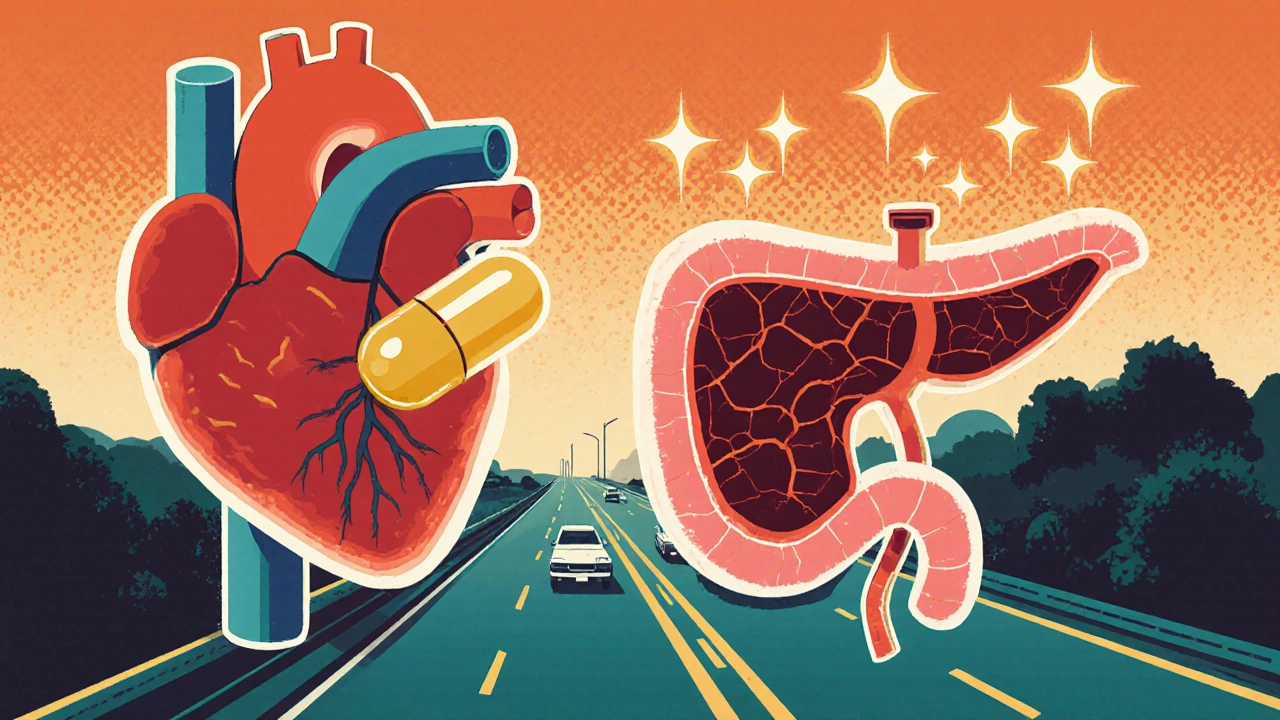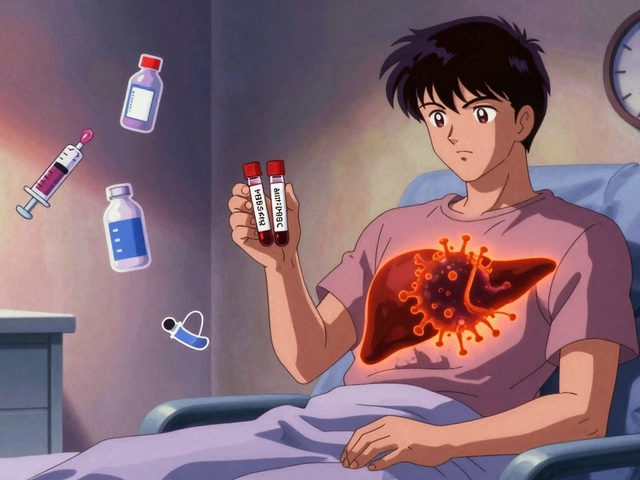
When you're prescribed a statin to lower your cholesterol, the goal is clear: protect your heart. But if you've noticed your blood sugar creeping up after starting the medication, you're not alone. Thousands of people on statins report similar concerns - and science backs it up. Statins can raise blood sugar levels in some people, and for a small group, that’s enough to push them into diabetes. It’s not a guarantee. It’s not even common for most. But it’s real - and knowing how it works can help you make smarter choices.
How Statins Affect Blood Sugar
Statins work by blocking a liver enzyme that makes cholesterol. That’s good for your arteries. But that same enzyme is part of a bigger system - the mevalonate pathway - that also helps your body manage insulin and glucose. When statins interfere with this pathway, they reduce important molecules like CoQ10 and geranylgeranyl pyrophosphate. These aren’t just random chemicals. They help insulin do its job. Without enough of them, your cells become less responsive to insulin. That’s insulin resistance - the first step toward type 2 diabetes.
Studies show statins also affect the pancreas. Beta cells, which produce insulin, start taking in more LDL cholesterol from the blood. That triggers inflammation and stress inside the cells. Over time, they don’t release insulin as well. One study tracking nearly 9,000 people found that those on statins had a 46% higher chance of developing diabetes over six years. That sounds scary, but here’s the catch: most of those people already had risk factors - extra belly fat, high blood pressure, or prediabetes.
The Dose Matters
Not all statins are created equal when it comes to blood sugar. High-intensity statins - like atorvastatin (40-80 mg) or rosuvastatin (20-40 mg) - carry more risk than lower doses. A major analysis from Oxford found that people on high-dose statins had a 36% higher chance of developing diabetes compared to placebo. Those on low doses? Just 10% higher. The difference isn’t just in strength - it’s in how deeply they disrupt your metabolism.
Atorvastatin seems to have the strongest effect on blood sugar among common statins. One 10-week study showed it increased insulin resistance even as the body tried to compensate by making more insulin. That’s why some people with existing diabetes notice their A1c rising after switching to a higher dose. It’s not that statins cause diabetes overnight. It’s that they nudge your body toward it - especially if you’re already close to the edge.

Who’s Most at Risk?
If you’re young, lean, and have perfect blood sugar, statins are unlikely to cause problems. But if you’re already in the danger zone, the risk climbs. Here’s who should pay closer attention:
- People with prediabetes - fasting blood sugar between 100-125 mg/dL
- Those with metabolic syndrome - belly fat, high triglycerides, low HDL, high blood pressure
- Individuals with a family history of type 2 diabetes
- People over 65, especially if they’re inactive or overweight
- Those taking other drugs like corticosteroids or diuretics
One study found that nearly 70% of new diabetes cases linked to statins happened in people who already had at least two of these risk factors. That means if you’re already borderline, a statin might be the final push. But again - it’s not inevitable. Lifestyle changes can often stop it before it starts.
Does This Mean You Should Stop Taking Statins?
No. Not even close.
Let’s put this in perspective. For every 1,000 people taking a high-intensity statin for five years, about 10-20 extra cases of diabetes might occur. But during that same time, those same people prevent 50-60 heart attacks, strokes, or deaths from heart disease. That’s a 3-to-1 benefit ratio. The American Heart Association, the American Diabetes Association, and the CDC all agree: for people who need statins, the heart protection far outweighs the diabetes risk.
Think of it like this: if you’re driving on a highway and your brakes are worn, you don’t stop driving because the car might need a repair. You get the brakes fixed - and you check them regularly. Statins are the brake fix. Blood sugar monitoring is the check-up.

What to Do If You’re on Statins
Here’s what actually works in real life:
- Get your blood sugar checked before starting - Ask for fasting glucose and HbA1c. This gives you a baseline.
- Test again at 3 and 6 months - If your numbers start rising, catch it early.
- Focus on movement - Just 30 minutes of walking daily cuts diabetes risk by 30%. It also helps statins work better.
- Watch your carbs - Refined sugar and white bread spike blood sugar. Swap them for whole grains, beans, vegetables, and healthy fats.
- Don’t panic over small changes - A 0.2% rise in HbA1c isn’t a crisis. It’s a signal to adjust your habits.
- Talk to your doctor before switching or stopping - Some people do better on pravastatin or fluvastatin, which have less impact on glucose.
One patient in Halifax, who started on atorvastatin for high LDL, noticed her fasting sugar jumped from 98 to 112 mg/dL in four months. She didn’t stop the statin. Instead, she started walking after dinner, cut out soda, and added a daily serving of oats. Six months later, her sugar was back to 96. Her doctor kept her on the statin. Her heart stayed protected. Her diabetes risk dropped.
What’s Next for Statins and Diabetes
Scientists are now looking for genetic clues. Some people have a variation in the SLCO1B1 gene that makes them more likely to develop high blood sugar on statins. In the next few years, a simple blood test might tell your doctor which statin is safest for you.
Meanwhile, research is exploring whether adding CoQ10 supplements helps offset the metabolic side effects. Early results are mixed, but it’s a promising area. Other studies are testing new cholesterol drugs - like PCSK9 inhibitors - that lower LDL without touching blood sugar. They’re effective, but much more expensive. For now, statins are still the go-to for most people.
The bottom line? Statins save lives. For the vast majority, the benefits are clear. For a small group, they nudge blood sugar higher. That doesn’t mean avoid them. It means be aware. Monitor. Move. Eat well. And work with your doctor to find the right balance - not just for your cholesterol, but for your whole body.
Do statins cause diabetes?
Statins don’t cause diabetes outright, but they can raise blood sugar enough in some people to push them over the diagnostic threshold. This happens mainly in those already at risk - like people with prediabetes or obesity. The increase is small, but real. For most, the heart benefits far outweigh this risk.
Which statin has the least effect on blood sugar?
Pravastatin and fluvastatin appear to have the smallest impact on blood sugar levels. Atorvastatin and rosuvastatin, especially at high doses, are more likely to raise glucose. If you’re at high risk for diabetes, your doctor might choose one of the gentler options.
Can I reverse statin-induced blood sugar changes?
Yes, in many cases. Lifestyle changes - weight loss, exercise, and cutting sugar - can bring blood sugar back down. Some people even see their HbA1c improve after switching to a lower-dose or less metabolically active statin. Stopping statins entirely is rarely recommended unless the diabetes risk clearly outweighs the heart benefit - which is rare.
Should I avoid statins if I have prediabetes?
No. People with prediabetes often benefit the most from statins because they’re at high risk for heart disease. The key is monitoring. Get your blood sugar checked before starting and again after 3-6 months. Pair the statin with lifestyle changes - that’s the best defense.
How often should I check my blood sugar if I’m on a statin?
If you have no diabetes risk factors, annual checks are fine. If you have prediabetes, obesity, or metabolic syndrome, get fasting glucose and HbA1c tested before starting the statin, then again at 3 and 6 months. After that, every 6-12 months is usually enough unless your numbers start rising.





11 Comments
just started simvastatin last month and my fasting glucose went from 92 to 108... i thought i was going crazy. then i read this and felt seen. not scared, just... aware. now i walk after dinner and swapped my morning bagel for avocado toast. no panic, just adjustments. 🌿
This is a well-researched and balanced overview. The key takeaway is that risk is contextual. For patients with established cardiovascular disease, the benefit-risk ratio remains overwhelmingly favorable. Regular monitoring and lifestyle intervention are not optional-they are integral to safe statin therapy.
Oh wow, so now the government wants us to take poison to save our hearts? Next they’ll say smoking’s good for lung health. This is why I don’t trust Big Pharma. They’ll sell you a heart attack cure and call it a ‘side effect’ while you’re paying $400 a month for it.
I KNEW IT. I told my doctor last year, ‘This statin is making me feel like my body is on fire!’ She laughed. Said I was ‘overreacting.’ Now I’m prediabetic and she says ‘It’s just a little rise.’ A LITTLE RISE?! I’ve been crying into my oat milk latte for weeks. My cousin’s uncle’s neighbor got diabetes from this and now he’s on insulin. I’m next. I just know it. 😭
Big thanks for this post! 👏 Totally agree with the ‘monitor, move, eat well’ mantra. I’ve been on rosuvastatin for 3 years. My A1c went from 5.4 to 5.8, so I started daily walks and swapped out all white carbs. Now it’s back to 5.3. Statin stays. Sugar stays down. Win-win. 💪
It is, of course, entirely unsurprising that the pharmaceutical industry, in its infinite wisdom, has engineered a compound that reduces cardiovascular mortality by 30%-yet somehow manages to induce metabolic dysfunction in a statistically insignificant subset. One must admire the precision of such unintended consequences. One also wonders: who funds the studies that declare this ‘acceptable risk’? Just a thought.
lol so i take my statin and now i got sugar probs? guess i should’ve eaten less donuts before i started. this is why i dont trust doctors. they give you a pill and then act shocked when you turn into a diabetic. also typo: ‘sugar’ not ‘sugur’ lmao
Here’s the thing nobody says out loud: statins don’t cause diabetes. They reveal it. Like a spotlight on a hidden crack in the foundation. If your body was already teetering on the edge, the statin didn’t push you-it just showed everyone you were about to fall. The real question isn’t ‘Do statins cause diabetes?’ It’s ‘Why were we so blind to the warning signs before we even started the pill?’
Let’s be real-this is just another way for Big Pharma to sell metformin. First they give you the statin that raises your sugar, then they slap you with a $120 prescription for insulin or metformin. Profit. The real scandal? They never tell you that 70% of these ‘new’ diabetics could’ve been reversed with 30 minutes of walking and no soda. But hey, pills sell.
I was on atorvastatin for 18 months. My A1c jumped from 5.5 to 6.7. I cried. I screamed. I Googled ‘statins cause diabetes’ 47 times. Then I stopped. My doctor said ‘No, don’t stop.’ I said ‘No, YOU stop lying.’ I switched to pravastatin. My sugar dropped back to 5.4 in 3 months. I’m not a lab rat. I’m a person. And I won’t be sacrificed for a 10% lower LDL.
While the data presented here is accurate and well-sourced, it is critical to emphasize that the absolute risk increase for statin-associated diabetes is low-approximately 0.1% to 0.2% per year in the general population, and approximately 1% per year in high-risk populations. The cardiovascular risk reduction, in contrast, is consistently 20% to 30% across multiple meta-analyses. Therefore, the clinical imperative remains: continue statin therapy in indicated patients, implement proactive glucose monitoring, and prioritize lifestyle modification as the primary mitigating strategy. The benefit-risk profile remains overwhelmingly favorable.